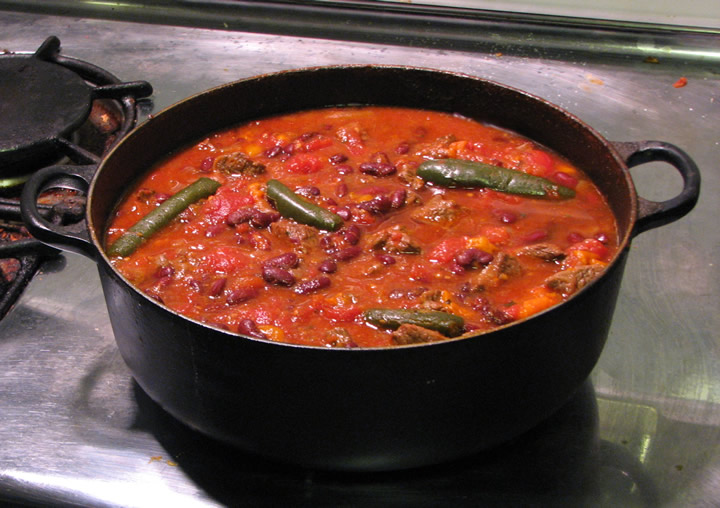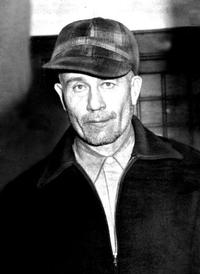the nightly encampments upon the historic Alamo Plaza, in the heart of the city, had been a carnival, a saturnalia that was renowned throughout the land.1
In the town of San Antonio, the Alamo Plaza transforms from a daytime marketplace into a lively nighttime fiesta. The plaza is bathed in twilight and flickering mesquite fires. The only other sources of light are distant street lamps and kerosene lanterns placed upon makeshift tables spread throughout the plaza. The lanterns shine and glimmer through colorful glass bottles, giving the plaza an effervescent glow. The sounds of the evening are boisterous, filled with the strum of guitars, the songs of troubadours, laughter, and a constant hum of conversation. Neighing horses, barking dogs, and cackling fowl can be heard in the distance. The aroma of simmering chili, grilled corn tortillas, and bitter coffee permeate the air. Hundreds of caterers sell their goods, and thousands of patrons wait to partake. This is the Chili Queens in their heyday, before it all came tumbling down. Eventually the plazas would silence, and the legendary Chili Queens would be lost to history.2

From dusk until dawn, the Chili Queens inhabited a nocturnal world in the plazas of San Antonio. But who were these legendary mujeres? What was it that elevated them to culinary royalty? “The Chili Queens” references the original purveyors of chili con carne, distributed at night throughout the plazas of San Antonio. These Queens were known for their delectable dishes ranging from their namesake, chile con carne, to enchilades, frijoles, tamales, chili verde, tortillas and to wash it all down, strong coffee, dark hot chocolate, or sweet atole. For a mere ten cents, you could enjoy a large bowl of chili with corn tortillas and cup of coffee.3
Aside from minor textual references dating back to the 1880s, historical accounts of individual Chili Queens do not exist. Researchers have pieced together components of their day-to-day lives through photographs, paintings, and various sources of journalism. Contrary to their royal title, Chili Queens were tough women working the night shift for a physically arduous job, with the goal of providing income for their families. Much like small, family owned restaurants of today, the process of operating a chili stand required all hands on deck. The family rented a plot of land in the plaza, and each day the pots, pans, food, and drinks to supply the stand had to be transported using a burro and wagon. The women of the family prepared portions of the food at home before bringing it to the plazas at night, where it was kept warm on charcoal braziers. Traditionally, the matron of the family was the main cook while the eldest daughter worked as hostess and served the patrons. Every morning, the supplies had to be packed up and transported back home until nighttime, when the cycle would repeat. Much more than just a nightly fiesta, life on the plazas was their livelihood.4

At the turn of the twentieth century, the Chili Queens became known for their charm just as much as their culinary creations. Patrons came to the plazas to eat but they stayed for the beguiling Chili Queens, who joked, bantered, and flirted with their customers. The Chili Queen image transformed from a hardworking mother into a dark haired Mexicana with a sharp wit and bewitching allure. Soon, the Chili Queens gained notoriety beyond San Antonio, garnering attention from reporters and tourists alike. In a 1927 Frontier Times article, Frank Bushick described the “raven-haired, flashing-eyed senoritas of more or less pulchritude who served the customers and presided with an easy grace.”5 In a 1934 publication entitled Glamorous Days, Bushick provides a more intimate portrait of a Chili Queen: “The Chili Queens were adept at the art of rolling their own cigarettes with corn shucks and black tobacco, and they would roll cigarettes for customers, some played guitar and sang, and when given a tip, the chili queen curtsied.” Bushick also alludes to their adeptness in dealing with the often rowdy clientele, “They had the gift of banter, could kid around with customers, and could swear to slow down familiarity or diffuse rough stuff.”6 Although the chili stands were a popular tourist destination, not all reviews were kind. Stephen Crane, author of Red Badge of Courage, wrote in 1895 that “upon one of the plazas, Mexican vendors with open-air stands sell food that tastes exactly like pounded fire-brick from Hades — chili con carne, tamales, enchiladas, chili verde, frijoles.”7 The compilation of reviews, both positive and negative, made one thing clear — the Chili Queens made a name for themselves as a vibrant force in San Antonio history.
Throughout their two hundred year history, the Chili Queens migrated throughout the plazas of San Antonio, forced to move by city expansion and civic reform. In 1877, the arrival of the railroad in San Antonio marked a boom in tourism and spurred business for working class vendors. According to Jeffrey Pilcher, a Mexican food historian, many of these visitors settled permanently, “tipping the demographic balance and pushing the Mexican population out of the city center into segregated barrios on the west side.8 Military Plaza, or Plaza de Armas, was the site of San Antonio’s first marketplace and the first home of the Chili Queens. In 1889, a new city hall building erected on Military Plaza forced the Chili Queens to move west of San Pedro Creek. The Chili Queens also operated out of Main Plaza, Alamo Plaza, Haymarket Plaza and Milam Park, continually on the move due to municipal restrictions. In the 1900s, the vendors ignored a ban on their business and returned to the Alamo Plaza, where city officials tolerated their presence. When World War I began in 1914, San Antonio became an important military training center, which again moved the Chili Queens out of the Plazas and across San Pedro Creek. This back and forth movement continued for the next few decades until finally the vendors were all secluded into the Westside of San Antonio, where a majority of the Mexican population lived in crude shacks called jacales, made up of dirt floors and grass roofs.9


Questionable sanitation was the pervasive theme responsible for the chili stand shutdowns. In 1937, with an election looming, Mayor Charles Kennon Quin deemed the chili stands unsanitary and banned them once again from the plazas. After much public outcry, the stands reopened. In 1939, Mayor Maury Maverick created a central commissary kitchen, with stipulations requiring each vendor to pass health inspections and display their passing cards for the public. The Chili Queens received official sanction to operate, but only within screened-in structures. This seemingly innocuous restriction stole the romanticism once emanated by the plazas. No longer could you enjoy a bowl of chili con carne under a starry Texas sky while captivated by an enchanting Chili Queen. The customers diminished, and the chili vendors followed suit. By 1943, health officials shut down the last remaining chili stands for unsanitary dish-washing facilities. The once lively plazas became abandoned and empty.10
The struggle for cultural and racial hegemony likely contributed to the end of the Chili Queen reign. An 1897 review from the San Antonio Express cautioned, “Ignorance in the details of their manufacture is necessary to the complete enjoyment of tamales. The abstinence seldom lasts long, however, for tamales have too rare a deliciousness to be renounced on account of a trifle of dirt.”11 It is debated whether the “trifle of dirt” the author mentions refers to the sanitary conditions of the prepared food or the racial quality of the women who made them. Early Anglo settlers claimed that “coyotes refuse chili seasoned Mexican carne.”12 These claims were especially damaging because Mexican women held the responsibility as carriers of culture, so the idea that chili stands were unsanitary enforced the harmful stereotype of the “dirty Mexican.”13 According to scholar Jeffrey Pilcher, “Anglos invented the chili queens in order to populate their fantasy heritage.”14 Thus, the exoticized and eroticized image of Chili Queens popularized in the 20th century was partly a product of Anglo marketing.
Eventually, entrepreneurs outside the Mexican community transformed the popular chili queen fare into a lucrative business opportunity through commercialization of chili powder, canned chili, and even canned tamales. The food processing industry was a profitable way to enjoy chili con carne without the imagined threat of racial contamination. In 1932, Elmer Doolin created a Tejano inspired snack from toasted corn tortillas, which he called Fritos. In addition, San Antonio was the birthplace of the first Pace Picante sauce.15
The Chili Queens may have vanished from the plazas of San Antonio, but their legacy will live on forever. These purveyors of chili con carne are the pioneers of Tex-Mex food. Once thought of as exotic dishes created by the descendants of Aztecs, Tex-Mex food is now a soothing and comforting dish, oozing nostalgia in each tasty bite. In 1977, the Texas Legislature even proclaimed chili con carne as the official state dish. Popular food trucks today owe their start to these open air chili stands.16
Aside from spurring a Tex-Mex revolution, the Chili Queens created a lasting impression. The plazas were almost otherworldly, a place where silk-hatted tourists, rough-handed vaqueros, soldiers, merchants, and traveling musicians were all were free and equal, sitting side by side to enjoy a bowl of chili con carne, happily spellbound by a Chili Queen. Although these mujeres dazzled many with their charms, they should be remembered as hard-working mothers, toiling day in and day out in grueling conditions. These women used their culinary skills to claim a public presence that was otherwise denied to them, and helped to pave the way for generations of women thereafter. According to scholar Pilcher, “Perhaps the greatest legacy of the chili vendors was their struggle to assert a form of cultural citizenship that helped to legitimize the Mexican presence in the multicultural mosaic of the United States.”17


It wasn’t just Mexican food on sale, but rather the romance of a vanquished people, a slice of Old Mexico in a state that hadn’t yet fully joined the Republic.18
- O. Henry and Paul J. Horowitz, “The Enchanted Kiss,” in Collected Stories of O. Henry (New York: Avenel Books Crown Publishers, 1979). ↵
- Marian L. Martinello, The Search for a Chili Queen: On the Fringes of a Rebozo (Fort Worth, Texas: TCU Press, 2009), 1-11. ↵
- Will Chapel Rogers III, “A History of Military Plaza to 1937” (Master’s thesis, Trinity University, May 1968), 48. ↵
- Marian L. Martinello, The Search for a Chili Queen: On the Fringes of a Rebozo (Fort Worth, Texas: TCU Press, 2009), 39. ↵
- Frank H. Bushick, “The Chili Queens of San Antonio,” Frontier Times 4, no. 10 (July 1927): 4-5. ↵
- Frank H. Bushick, “Glamorous Days” (San Antonio, TX: Naylor, 1934). ↵
- Frank W. Jennings, “Popular Chili Queens Graced San Antonio Plazas,” Journal Of The Life And Culture Of San Antonio (n.d.), http://www.uiw.edu/sanantonio/jenningschiliqueens.html. ↵
- Jeffrey M. Pilcher, “Who Chased Out the ‘Chili Queens’? Gender, Race, and Urban Reform in San Antonio, Texas, 1880–1943,” Food and Foodways 16, no. 3 (2008):176. https://doi.org/10.1080/07409710802304168. ↵
- Edmund Tijerina, “Chili Queens Once Ruled Alamo Plaza,” San Antonio Express News, January 28, 2015, https://www.expressnews.com/150years/culture/article/Chili-Queens-romanticized-sometimes-shunned-6047507.php. ↵
- Donna R. Gabaccia and Jeffrey M. Pilcher, “Chili Queens’ and Checkered Tablecloths,” Radical History Review 110 (Spring 2011): 109–26, doi:10.1215/01636545-2010-028. ↵
- Jeffrey M. Pilcher, “Old Stock’ Tamales and Migrant Tacos: Taste, Authenticity, and the Naturalization of Mexican Food,” Social Research 81, no. 2 (2014): 441–462, doi:10.1353/sor.2014.0018. ↵
- Jeffrey M. Pilcher, “Who Chased Out the ‘Chili Queens’? Gender, Race, and Urban Reform in San Antonio, Texas, 1880–1943,” Food and Foodways 16, no. 3 (2008):179. https://doi.org/10.1080/07409710802304168. ↵
- Jeffrey M. Pilcher, “Who Chased Out the ‘Chili Queens’? Gender, Race, and Urban Reform in San Antonio, Texas, 1880–1943,” Food and Foodways 16, no. 3 (2008):175. https://doi.org/10.1080/07409710802304168. ↵
- Jeffrey M. Pilcher, “Who Chased Out the ‘Chili Queens’? Gender, Race, and Urban Reform in San Antonio, Texas, 1880–1943,” Food and Foodways 16, no. 3 (2008):175. https://doi.org/10.1080/07409710802304168. ↵
- Frank W. Jennings, “Popular Chili Queens Graced San Antonio Plazas,” Journal Of The Life And Culture Of San Antonio (n.d.), http://www.uiw.edu/sanantonio/jenningschiliqueens.html. ↵
- Frank W. Jennings, “Popular Chili Queens Graced San Antonio Plazas,” Journal Of The Life And Culture Of San Antonio (n.d.), http://www.uiw.edu/sanantonio/jenningschiliqueens.html. ↵
- Jeffrey M. Pilcher, “Who Chased Out the ‘Chili Queens’? Gender, Race, and Urban Reform in San Antonio, Texas, 1880–1943,” Food and Foodways 16, no. 3 (2008):195. https://doi.org/10.1080/07409710802304168. ↵
- Arellano Gustavo, Taco USA: How Mexican Food Conquered America, (New York, NY: Scribner, 2012), 32. ↵



87 comments
Tala Owens
I’m glad this article introduced me to the Chili Queens. It’s always great seeing women get together. They created something that brought their culture and heritage to San Antonio and that’s amazing. It’s sad that it was so difficult to keep the business withstanding. It seemed as if they were loved as well as they were hated but the hate kept coming. I still think what they accomplished was admirable.
Paola Arellano
The article is quite intriguing as it exemplifies some history from San Antonio. Although I am not from San Antonio I think that the story shows a lot of cultural diverse city as well as portrays how food can play a major part in the building of a community. The Chili Queens earn their spot in the charts and really fight to keep their business alive. The fact that they were Mexican of course made me relate to them and a lot of the food that they would cook my own mother and grandmother would do so as well for this reason I think that this article was very well written and showed how develop San Antonio can be.
Thomas Fraire
This is an amazing article, I really enjoyed it! I researched the chili queens last semester and I think it is really cool someone covered history so close to home. I really think San Antonio culture was captivated and portrayed well in this article! I love how in depth the research on this topic was. It is really cool how these women came together to make money and share there culture
Danniella Villarreal
This was such an amazing read, it is nice to learn something new about the place I’ve grown up in. I never even knew there was a thing called the chili queens. Since I really like chili this article was extremely enjoyable.
Krystal Rodriguez
I was born and raised in San Antonio but had never heard of the Chili Queen. I love how descriptive the first part of the article is and how it captivates the audience into our culture. It is sad to hear that this can’t be found here anymore. Im sure it would have been very fun and welcoming to see this all in person.
Chelsea Alvarez
This article was very captivating for me. I really enjoyed the way that the introductory paragraphs laid out a setting for me. Prior to reading this article, I had no idea what or who the Chili Queens were. It is both cute and inviting of women to gather and make meals to sell in public places of gathering. This article really showcases San Antonio’s traditions and hospitality, and it is a shame that they can no longer be found throughout the city.
Vanessa Sanchez
This is an amazing article. It was pretty awesome to learn something new about San Antonio. Specially to someone who is not raised and born from here. I have never heard about the Chili Queens till i read this article. It sucks to see how something so wonderful has to move just because of racial segregation. I am personally I huge fan of chili and thanks to the Chili Queens I got to truly enjoy of this.
Sarah Uhlig
I didn’t like how they were almost banned for their work. But the culture of how these women contributed to the chili for San Antonio is very cool. I liked reading about the Chili Queen’s but I didn’t like how they were being pushed away for their own culture. Their work and dedication made a difference in how their food is incorporated into San Antonio’s culture. I really liked this article and how it specifically pertained to the culture of our city.
Amariz Puerta
Wow this feautered picture made my mouth water and the title was very intriguing. I knew that san antonio was full of history but never knew about this, and now that i do im so glad. I wish it would have not died out because these 10 cent deals would have came in handy. The chili queens are such part of our history truly enjoyed reading this.
Mariah Garcia
As a native of San Antonio, I was not familiar with the concept of the Chili Queens, and as such, this was an extremely enjoyable article. I love my city, and this concept of the Chili Queens reminds me of the taco trucks and street vendors that have permeated throughout the zeitgeist of American pop culture. It is amazing to think of what Alamo Plaza once looked like, especially when it is compared to what we see today: a myriad of storefronts and tourist traps.